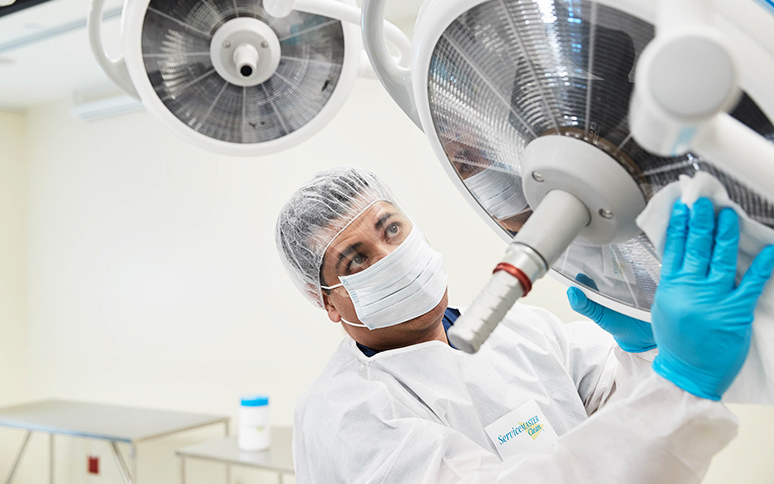Cross Contamination Prevention in Healthcare Facility
Germs and viruses can’t be avoided, but healthcare facilities must be especially vigilant in controlling them – and if the proper steps aren't taken to avoid it, cross-contamination in hospitals and other healthcare settings can put staff and patients at increased risk.
The spread of bacteria and other pathogens is particularly concerning for people with compromised immune systems, so it’s critical to have cleaning protocols that properly mitigate the threat of cross-contamination. The experts at ServiceMaster Clean designed our patient-centered cleaning program with cross-contamination prevention in mind. Use these three tips from our environmental cleaning specialists to help prevent cross-contamination in your healthcare facility:
1. Use the Right Cleaning and Sanitation Supplies
In order to prevent harmful bacteria from spreading, your staff need to know the difference between cleaning, sanitizing, and disinfecting. They also so need to have the right cleaning supplies to do the job properly:
Microfiber cloths. Microfiber does a far better job of picking up dirt, debris, and germs than traditional cleaning materials. A combination of clean water, a commercial detergent, and a microfiber cloth is ideal for basic surface cleaning.
Hospital-grade disinfectant. Once a surface or an item has been cleaned, it can then be disinfected. Healthcare facilities must use hospital-grade disinfectants to prevent cross-contamination.
Alcohol-gel hand sanitizer. Keeping alcohol-based hand sanitizer widely available throughout your healthcare facility can help stop the spread of germs from hand-to-surface, hand-to-hand, and hand-to-mouth contact.
Beyond using the right supplies, keeping soiled and clean materials separate and following proper laundry procedures are also critical for reducing the risk of cross-contamination in healthcare environments.
2. Schedule Routine Environmental Cleaning
Regular cleaning, sanitizing and disinfecting help control viruses and bacteria before they have a chance to spread from one surface or room to another. Items and surfaces that are touched frequently are more prone to contamination and, therefore, require more frequent and thorough cleaning. All staff should be trained on basic cleaning protocols for healthcare settings, especially high-touch areas, to minimize the risk of cross-contamination.
High-touch surfaces in healthcare settings include:
- Door handles
- Bed rails
- Bedside tables
- Bathroom faucets
- Toilet seats and flush handles
- Telephones
- Elevator buttons
- Hand sanitizer dispensers
3. Encourage Proper Hand Hygiene Among Your Staff
Proper hand hygiene is the simplest, but perhaps the most important, component of preventing cross-contamination in healthcare facilities. Proper hand hygiene consists of just a few easy steps:
- Wet hands with water.
- Apply soap, lather, and scrub vigorously for at least 20 seconds.
- Pay attention to all surfaces of the hands, including fingernails.
- Rinse thoroughly and dry hands using a clean cloth, air dryer, or disposable towel.
Put a stop to the spread of germs and viruses by ensuring that your staff are washing their hands in the correct manner and at the correct times. According to the Centers for Disease Control and Prevention (CDC), hand hygiene in healthcare facilities should be performed in the following situations:
- Before eating.
- Before and after contact with a patient's skin.
- Before moving to a clean body site after contact with a contaminated body site.
- After using the washroom.
- After removing gloves.
- After contact with any inanimate object near a patient.
- After contact with bodily fluids or broken skin.
- After dressing a wound.
While your staff play a crucial role in the day-to-day prevention of cross-contamination, it’s also recommended that healthcare facilities partner with an experienced environmental cleaning provider with documented janitorial procedures designed to reduce the risk of cross-contamination. Call the experts at ServiceMaster Clean to learn more about our customized healthcare cleaning programs and the procedures we use to help prevent cross-contamination.








